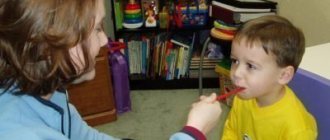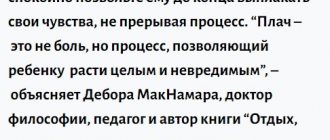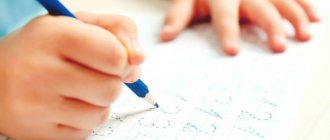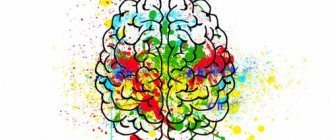Hello! Have you ever encountered the following situation? We check the child’s writing notebooks and notice a huge number of errors. This is not necessarily a sign of laziness or illiteracy, because there is such a disorder of written speech and mental functions of the brain as dysgraphia in children
Concept
What is dysgraphia?
In one of the previous articles we touched on the topic of dyslexia. It was also said there that these are similar developmental disorders, and they almost always overlap, but do not always accompany each other. In Russia, more than thirty percent of primary school students have this problem, so the disorder is common and it is very important to learn to recognize it, understand its causes and know how to help children with such a problem.
Dysgraphia is a disorder of written speech in which the child makes obvious mistakes when writing and which requires speech therapy correction.
Like dyslexia, dysgraphia has several forms, each of which has its own characteristics, and, more precisely, its own types of errors made by children. The following forms of dysgraphia can be distinguished:
- Acoustic
- Articulatory-acoustic
- Optical
- Ungrammatical
- Dysgraphia associated with underdevelopment of language analysis and synthesis
Symptoms
Acoustic
This form of impairment involves poor phonemic awareness. The student writes by replacing letters that represent similar sounds. For example, paired consonants “b” / “p”, “d” / “t”, “g” / “k”, consonant vowels “o” / “u”, “e” / “yu” or complex sounds and their components “a” / “i”, “ts” / “s”, “ts” / “t”, “h” / “shch” and so on.
With acoustic dysgraphia there are no problems with hearing and oral speech
.
Articulatory-acoustic
In this case, the symptoms described above remain, only errors in the pronunciation of sounds are added to acoustic dysgraphia. In fact, it is a combination of acoustic and phonemic dyslexia. The child reads and writes words incorrectly and confuses similar sounds. Articulatory-acoustic occurs in children with phonetic-phonemic speech disorders.
Ungrammatical
This disorder is associated with lexico-grammatical underdevelopment of speech. The baby writes and speaks without fully realizing the meaning of the words. It is difficult for him to find synonyms or antonyms, to describe something, or to form the necessary form of a word (for example, a diminutive or plural). There may also be problems in constructing complex sentences (for example, he omits one or another part of the sentence or breaks their sequence). Agrammatic dysgraphia is often found in bilingual families.
Optical
In this case, the baby confuses visually similar symbols. He can add or subtract elements of letters, resulting in both existing and non-existing characters. For example, you can confuse “X” and “F”, “A” and “L”, and from the letter “E” you can make “S” in reverse. Also, sometimes with optical dysgraphia, letters are mirrored.
Associated with underdevelopment of language analysis and synthesis
Despite the complex name, this type of dysgraphia is quite simple to identify. A student suffering from it, in the process of writing, misses letters or syllables, changes their places, duplicates or even adds something that is not there. Also, a student may confuse where a space is needed and where not, or not complete words. There are also problems in defining the boundaries of the proposal.
Prognosis and prevention
To overcome dysgraphia, the coordinated work of a speech therapist, teacher, neurologist, child and his parents (or an adult patient) is required. Since writing disorders do not disappear on their own during schooling, children with dysgraphia should receive speech therapy help at the school speech clinic.
Prevention of dysgraphia should begin even before the child begins to learn to read and write. Preventive work must include the targeted development of HMFs that contribute to normal mastery of the processes of writing and reading, sensory functions, spatial representations, auditory and visual differentiation, constructive praxis, and graphomotor skills. Timely correction of oral speech disorders, overcoming phonetic, phonetic-phonemic and general speech underdevelopment is important.
Reasons for rejection
Why does a child write poorly or why does a child read poorly? Not surprisingly, the causes of dysgraphia are similar to the causes of dyslexia.
- Hereditary predisposition
- Diseases suffered during the perinatal period of development, as well as various complicating factors (bad habits of the mother, complicated toxicosis, asphyxia, short interval between the mother’s pregnancies, and so on)
- Internal functional reasons (long-term somatic diseases, etc.)
- External functional reasons (improper speech education)
- Lack of school readiness
- Minimal brain dysfunction
- Impaired mental function
- Attention Deficit Hyperactivity Disorder
- General speech underdevelopment
- Strokes, traumatic brain injuries, neurosurgery and brain tumors (possibly in adulthood)
Dysgraphia, like dyslexia, can lead to many problems. Among them are a drop in educational motivation, underdevelopment of speech, school failure, undeservedly poor performance, and so on. Therefore, it is very important to realize that it is not the child’s fault that he writes incorrectly, and this problem is not related to his schooling.
Responsibility for correcting the violation lies, of course, with specialists, but first of all, with parents!
As well as for the development of their pet in general. All that is required of teachers is to help recognize the problem in time and provide conditions in the classroom that promote the harmonious development of children, including the correction of dysgraphia.
But is it possible to confuse dysgraphia and other developmental disorders?
How not to do this?
Treatment of dysgraphia in adults
Dysgraphia in adults is a fairly common phenomenon nowadays. The causes of the disease may be a consequence of any mental disorders or injuries. Usually in an adult there are several forms at once. For example, an optical variation and agrammatism can be observed, which is caused by impaired motor skills and visuospatial orientation. Patients cannot distinguish letters that are similar in their spelling: b-v, b-b, sh-shch, g-r, o-a, etc.
In an adult, dysgraphia may appear after a stroke, brain tumor, or neurosurgery. Symptoms of the disorder in such patients include absent-mindedness, slurred speech, hearing and vision impairment.
When diagnosing dyslexia in adults, the characteristics of writing and handwriting are studied, and a self-diagnosis method is also used, in which the patient himself monitors errors. Adults can do all written and oral activities independently, but under the supervision of a speech therapist.
Diagnostics
Unfortunately, you will not be able to diagnose your baby yourself. You will have to undergo examination by a number of specialists, among them: a neurologist, an ophthalmologist, an otolaryngologist, a speech therapist and a psychoneurologist (the latter, in fact, make the final diagnosis). Each of the doctors checks whether the subject has any health problems that could lead to a disruption in the writing process, in addition to dysgraphia. Let's assume that the diagnosis has already been made. The main question that faces us now is how to deal with dysgraphia in a child?
Correction
Any doctor will tell you that you cannot self-medicate, and this is true.
Basically, a speech therapist works with dysgraphia, but a neuropsychologist, a psychotherapist, and an educational psychologist can also work.
You should be prepared for the fact that fixing the problem will not be quick. The correction program is built depending on the causes, type of violation and age. The older he is, the more difficult it is to carry out the correction. If there is an organic cause of dysgraphia, then its treatment will be prescribed (medication, physiotherapy, and so on). Various exercises will be carried out with a speech therapist. You can apply some of them yourself and work with your child at home, in this way you will not only help with the correction, but also get closer to your baby.
Exercises for home
Is it possible to correct and how to correct dysgraphia at home? Yes, after consultation with a speech therapist, the main burden falls on doing the exercises at home. Below are exercises for correction. You can apply them and practice them yourself. This way you will not only help the correction, but also get closer to your baby.
"Labyrinth"
You need to go through the labyrinth by drawing a continuous line on a piece of paper without lifting your hand or turning the labyrinth.
Graphic dictations
These are tasks in which you need to draw something on a checkered sheet of paper based on prompts. There are graphic dictations in which a letter or number must be obtained.
Construction of signs from elements
You can make letters and numbers from different objects: counting sticks, pencils, cereals, plasticine, and so on. You can draw drawings on paper in the form of signs. From already composed symbols, you can rebuild others. Take them apart and put them back together.
Schulte tables
Schulte tables, the Munstenberg technique and other psychological methods for developing attention related to symbols. According to psychologists, this is especially effective when the child is between 10 and 11 years old.
Crosswords
Scanwords, crosswords, English crosswords, Sudoku and other puzzles.
Recognition of incomplete characters
Play recognizing letters and numbers that are not fully drawn. Let the child add the part of the sign that is missing. Some designs can be continued into several different characters. For example, the letter "B" and the number "5" have a common part, like many others.
Finding missing letters
Write a word and deliberately leave out a letter or even a syllable. Let the child find the mistake and name the correct spelling of the word.
Memorizing poems
This is also a kind of exercise that develops memory and speech. In our case, poetry will help us gain a sense of rhythm in speech.
Play with words
Make anagrams: rearrange letters and syllables in words so that they form new words or phrases. You can also take some medium or large word and try to make other words from the letters included in it. There are a lot of similar techniques.
Development of fine motor skills
It seems that everyone around is already repeating this: the development of speech is associated with fine motor skills. Make the most of this opportunity: let your child take a break from the Russian language and take up modeling, beads, construction sets, origami and other interesting activities. Turn on your imagination - and you will succeed. In addition, it will be extremely interesting for both you and your child to study!
Psychological comfort
You must provide your pupil, first of all, with psychological comfort, because without it the problem will either not be solved, or will be solved, but with consequences of a different nature. Fear of the teacher, hatred of writing and lessons, shame in front of classmates and more.
- Talk to teachers. Explain the seriousness of the situation and ask them to behave competently. Let them not focus the attention of other children on the problem and be patient. The teacher's duty is to treat his student with understanding. This means helping, stopping the ridicule of others and not scolding for mistakes. A teacher who does not understand this can not only interfere with the correction of dysgraphia, but also lead the student to mental problems. Just imagine the situation. You are a small child of 8 years old who cannot do what others do easily. At the same time, an adult, a teacher with whom you often have contact, scolds you for your mistakes, while your peers ridicule them. And this continues for quite a long time, day after day. I think it is obvious that the little person will have neither educational motivation, nor trust in others, nor healthy self-esteem.
- Charge your child only with positive energy. Praise your child for successes more often and do not talk about bad things. It is very important that he believes in himself and does not give up, that is, does not stop doing the exercises just because he is tired or something does not work out. At the same time, do not force him to overwork: everything should be in moderation. Otherwise, breakdowns cannot be avoided. Remember that parents are the most important thing your son or daughter has. They are his best friends and the closest people in his life. Who, if not you, will support the baby and help him succeed?
How to recognize a student with dysgraphia?
If you want to help students who may be suffering from dysgraphia , consider whether you have noticed the following symptoms .
- Doesn't always complete the text and sometimes misses individual letters.
- Speaks out loud when writing.
- Has difficulty finding the right words and is unable to express his thoughts in writing.
- He gets nervous if he has to write something, and sometimes he simply refuses.
- It happens that individual letters cannot be made out at all.
- Holds a pen or pencil incorrectly.
- Sees letters where there are scribbles and squiggles.
- Makes spelling mistakes and does not complete sentences.
- Writes indiscriminately either uppercase or lowercase letters.
- In large text, the lines meander, more like a drawing than a set of letters.
- Writes on a sheet of paper placed upside down or at an odd angle.
- Noise/music and crowds of people upset and depress such a child, as a result of which his thoughts begin to get confused.
- Sensitive to artificial light.
- Sometimes, while writing, his hand or forearm hurts.
- Does not get along well with lined or squared paper - because he is not able to write in a clearly limited space.
- Feels tired in the middle of the school day.
- Struggling with homework, spending a lot of time on written assignments.
- It is difficult for them to work independently, they lag behind their classmates and turn in work and assignments later than others.
If any of your students exhibits at least one of these signs, then you, the school, and the parents should make every effort to provide the child with maximum emotional support, not to mention specific learning assistance. Try to put the following tips and techniques into practice.
What is important to know about dysgraphia
- Dysgraphia is the most likely consequence of dyslexia. Since a child reads first and then writes, problems in reading are transferred to problems in writing. He first reads incorrectly and then writes incorrectly.
- Dyslexia and dysgraphia can occur in adults. If corrective work is not carried out on time, then these speech disorders can remain with the person for life. Accordingly, they will cause him more problems.
- Sometimes correction of dysgraphia is a long process. Parents need to be prepared for the fact that sometimes correction of dysgraphia, dyslexia and other related speech disorders may take more than one month or even one year, but several years. Willpower and patience will be required.
- If you have questions about how to treat dysgraphia, then dysgraphia is not a disease. And not even a mental disorder. This is only a disorder of speech development associated with the functioning of the brain. Therefore, it would be incorrect in this case to use the words “treatment”, “sick”, “disease” and others. However, it is also inappropriate to assume that this will “go away on its own.”
- Dysgraphic handwriting may be unclear. This is often associated with a violation of the motor and visual analyzers, so a child suffering from this may write illegibly and crookedly.
At-risk groups
There are certain risk groups for children who may develop dysgraphia.
- If he comes from a multilingual family;
- Previously had problems with speech;
- Left-handed or ambidextrous (a person for whom the left and right hands are equivalent);
- He started talking late;
- Left-handed, who was retrained to be right-handed;
- With disorders of phonetic perception;
- Has memory or attention problems;
- A student with a low level of school readiness;
- He writes as he speaks;
- Makes a small number of mistakes typical of dysgraphics.
Interest
Games will help to interest the child. This is especially true if preschool children have dysgraphia.
If a child does not want to correct the violation, does not want to write and study, then exciting games will come to the rescue.
With your support, correction of dysgraphia will turn from backbreaking work into leisure.
Development of mental functions
The development of mental functions can help in the prevention of speech disorders. Activities for the development of fine and gross motor skills, attention, memory, thinking, intelligence, phonemic hearing, musical hearing, spatial perception, emotional-volitional qualities and other things will be of great benefit in preventing speech problems. In addition, developing a child’s psyche in itself is always useful and at any age (even when he is no longer a child).
Statistics
The statistics on dysgraphia are astounding. According to research, approximately half of 2nd grade students have dysgraphia.
In a regular school this figure is almost forty percent.
This is due to the fact that about half of first-graders have phonetic-phonemic speech underdevelopment (FFS) or general speech underdevelopment (GSD), which prevents the child from becoming literate.
Compensation for underdevelopment
Dysgraphia is not a death sentence
Of course, the violation is corrected. But it is also worth noting that some people highlight a peculiar advantage of dysgraphia. The fact is that the human brain has compensatory capabilities. This means that he can compensate for any underdevelopment with something else. That is, if any ability of the brain is impaired, then another may be even too well developed. This fact and certain “statistics” may be the basis for the myth that dysgraphia (along with dyslexia) is a “disease of geniuses.” Indeed, we can observe that many geniuses suffered from this deviation. Among them are Albert Einstein, Hans Christian Andersen, Thomas Alva Edison, Michael Faraday, Agatha Christie, Walt Disney, John F. Kennedy, Vladimir Mayakovsky, Steve Jobs and many others.
For teachers and parents “Methods for correcting dysgraphia”
Methods and techniques for correcting dysgraphia
among younger schoolchildren
Dysgraphia - in practice, this diagnosis usually frightens many parents, but it should be noted that there are successful methods of correctional work with primary schoolchildren.
As you know, any “disease” is easier to prevent than to treat.
Dysgraphia is a specific disorder of speech activity in children - it is a violation of the acquisition and functioning of school writing skills. (V.I. Liaudis, I.P. Negure 1994)
Dysgraphia risk group:
- These are those children who have a history of diagnoses of phonetic-phonemic speech underdevelopment (FFSD),
- General speech underdevelopment (GSD);
- Phonetic speech underdevelopment (FSD);
- Various neurological symptoms;
- Minimal cerebral dysfunction (MCD);
- Encelopathy;
- Prenatal and postnatal pathology.
What should parents be wary of?
- Decreased auditory-verbal memory;
- Violation of letter gnosis;
- Violation of dynamic praxis of the hand;
- Difficulty in perceiving the rhythmic structure of a word;
- Unclear diction, poor articulation;
- Violation of the lexical and grammatical structure of speech;
Difficulties in mastering writing can be diagnosed already in the preparatory group of kindergarten.
(In elementary school this is the end of the first quarter).
Methods of speech therapy work in primary school.
Traditional directions (R.I. Lalaeva, 1999; L.G. Paramonova, 2001) of speech therapy work to overcome dysgraphia in children of primary school age include, first of all, the elimination of deficiencies and underdevelopment of children’s oral speech (improving phonemic perception, correction of sound pronunciation disorders and consolidation of correct sound-letter connections; development of vocabulary and improvement of grammatical design of speech; formation in children of ideas about a word, sound, syllable, sentence and the formation of skills in language analysis and synthesis, as well as work on the development of visual gnosis, memory, analysis and synthesis in children) . The organization of speech therapy work to overcome dysgraphia in school-age children can be carried out in several methodological approaches. The first approach corresponds to the modern theory of speech therapy and is based on the results of speech therapy diagnostics of children with writing problems. This approach is based on the principle of preferential influence on the “weak” link or links of the writing system, their formation taking into account the child’s zone of proximal development and normative age standards. Let's present several leading (and traditional) areas of work:
- improving the phonemic differentiation of speech sounds and mastering their correct letter designation in writing - correction of dysgraphia due to impaired phonemic recognition (or acoustic);
- correction of sound pronunciation defects and improvement of phonemic differentiation of sounds, mastering their correct letter designation in writing - when correcting acoustic-articulatory dysgraphia;
- improving the skill of arbitrary language analysis and synthesis, the ability to reproduce in writing the sound-syllable structure of words and the structure of sentences - when correcting dysgraphia due to the immaturity of language analysis and synthesis;
- improvement of syntactic and morphological generalizations, morphological analysis of word composition - when correcting agrammatic dysgraphia;
- improvement of visual perception, memory; spatial representations; visual analysis and synthesis; clarification of speech designation of spatial relationships - when correcting optical dysgraphia.
The second approach to overcoming dysgraphia can be carried out in line with the large-scale correctional and developmental work of a school speech therapist, which is built in accordance with the methodological recommendations of A.V. Yastrebova (1996). This approach has not only a correctional, but also a preventive focus and allows the school speech therapist to reach a large number of students. The work is built simultaneously on all components of the speech system - the sound side of speech at the first stage, the lexical and grammatical structure at the second stage, and the third stage - filling gaps in the formation of coherent speech. In this direction, the author identifies the following tasks: the development of speech-thinking activity and independence, the formation of full-fledged educational skills and rational methods of organizing educational work, the formation of communication skills, the prevention or elimination of dysgraphia.
We can also highlight a third approach highlighted by I.N. Sadovnikova (1997). This approach, like the first, is based on the results of a speech therapy examination of children with dysgraphia, which allows us to identify defective parts of the functional writing system, study the types and nature of specific errors in writing, and on this basis determine the leading directions of speech therapy correction.
However, unlike the first, this approach to correction does not involve correlating the identified disorders with one or another type of dysgraphia, and does not imply strict adherence to any specific algorithm in the process of speech therapy work. Thus, among the leading ones, I. N. Sadovnikova (1997) identifies the following areas of work on the correction of dysgraphia: the development of spatial and temporal concepts; development of phonemic perception and sound analysis of words; quantitative and qualitative enrichment of the dictionary; improvement of syllabic and morphemic analysis and synthesis of words; mastering the compatibility of words and conscious construction of sentences; enriching students’ phrasal speech by introducing them to the phenomena of polysemy, synonymy, antonymy, homonymy of syntactic constructions, etc.
Researcher E.A. Loginova [6] believes that a simplified version of the symptomatic approach is also possible - when a speech therapist unites schoolchildren (not necessarily with severe dysgraphia) on the basis of the commonality of one or another type of errors made in writing. These children are given a certain number of lessons dedicated to overcoming errors of this type.
All of the approaches described above to the correction of dysgraphia in primary schoolchildren are aimed, first of all, at improving the oral speech and language abilities of children, the formation of operational and technological means that constitute the basic level of organization of a specific type of activity - writing. This corresponds to the traditional understanding of dysgraphia in speech therapy as a reflection in writing of the inferiority of the linguistic development of younger schoolchildren.
Researcher L.S. Tsvetkova (2005) proposed such an approach to the formation of writing, “from the whole to the part and from meaning to meaning,” or “analysis through synthesis,” which involves teaching writing in the direction from idea to text, to phrase, etc., and then (or simultaneously) the formation of means of written expression of thought (operations in the structure of writing). Speaking about teaching writing, she recommends that after children have mastered the first skills of writing letters and a number of words, they should develop the psychological level of writing: forming a motive (why write?), reviving interest in writing certain content (intention), thinking, comprehending the content of the letter. This means that you first need to update the meaning of the word, and then analyze its constituent parts. A word is firmly stored in memory only if both its empirical and categorical meaning have been learned. This approach to teaching increases the general and intellectual activity of children, promotes the actualization of images of whole words and individual letters, and revitalizes the work of the corresponding groups of analyzer systems. The principle of semantic learning and teaching writing from the whole to the part is based on modern scientific concepts of psychology, linguistics, and physiology.
Corrective action in eliminating dysgraphia is carried out using various methods. The choice and use of one or another method is determined by the nature of the writing disorder, the content, goals and objectives of correctional speech therapy, the stage of work, the age, individual psychological characteristics of the child, etc.
When considering methods for correcting writing, we rely on the psychophysiological level of organization of written speech. Methods of psychophysiological development of writing, the most important component of the development of a student’s written speech, are described in detail by L.S. Tsvetkova. They form the basis for the development of phonetic-phonemic processes. The structure of writing is represented by psychological, psycholinguistic and psychophysiological levels. The formation of writing and its flow is possible only with the interaction of all these levels.
Based on this, we will consider several methods of corrective action to eliminate dysgraphia.
Method of sound-letter recognition. Finding a letter that corresponds to a certain sound: among a large number of letters; writing a letter in a notebook; underlining words with a given sound and writing them down in a notebook; crossing out the desired letter in a word, sentence, text; selecting the corresponding picture, the name of which contains the sound being practiced.
Word scheme method. The child is given a picture of an object and a ready-made diagram of the word. He names the object shown in the picture, and then the sounds of the word in order. Next, you need to correlate each sound with a letter and write down the word.
A method of matching the initial letter with a word and a picture. The child is asked to choose a word(s) or picture(s) for a given sound and label the sound with a letter.
Ebbinghaus method. (Words with missing letters). Practiced words are given, but with missing letters. You need to insert the missing letters, read the word, write it down.
Error correction method (visual). Misspelled words are given. The written words correspond to the sounding model of the word. It is necessary to find and correct the error and write the word correctly.
Method of sound-letter analysis. The child is offered a picture. You need to name the object and write down the word. Put emphasis on the word. Determine the number of syllables and name them, separating each syllable in the word with a dash. Next, name the sounds of the word in order and mark it with the appropriate color. Underline the consonants in the word. If a letter denotes a voiced sound, underline it with one line; if it denotes a dull sound, then underline it with two lines. Compare the number of letters and sounds in a word.
Structural method. The student is given a word in which he must sequentially determine the number of consonants and vowels. Next, the child makes a diagram for the word: a consonant is a shaded circle, a vowel is an outline. At first, the work is carried out on monosyllabic words without consonants, then the task becomes more complicated.
Properly done work will allow the child to develop the process of sound discrimination, phonemic hearing, auditory-verbal attention, understanding of the close relationship between the meaning of a word and its constituent sound-letters, and the ability to write words arbitrarily, consciously, and analytically. After this, you can proceed to the formation of writing words, sentences and texts [11].
For each type of dysgraphia, a certain procedure for correcting writing impairment has been established: either at the psycholinguistic level or at the psychophysiological level. But the methods of work at the psychophysiological level remain unchanged - these are ideas about sound and the connection between sound and letters. At the same time, the psychological level of development of writing must be present - this is the motive and desire to write.
In addition to using various methods of working with younger schoolchildren with dysgraphia, correctional work should include tasks at different levels, where the following techniques are practiced:
So, at the stage of working with letters, you can offer children the following tasks:
- name the letters written on the cards correctly and mirrored;
- laying out letters from sticks, focusing children’s attention on how their elements are arranged;
- feeling letters made of cardboard or sandpaper with closed eyes, recognizing them, correctly positioning them on the table, inventing words with them;
- “What does the letter look like?” Drawing letters by association, for example, “P” - gate, crossbar, “G” - hanger, “CH” - chair;
- Dermalexia - recognition of a letter “written” on the back, on the palm, in the air, on the table;
- tracing letters using a stencil;
- coming up with words containing a given letter in a certain position.
At the syllable level, students:
- come up with words containing a given syllable in a certain position (beginning, middle, end of the word);
- make up syllable patterns;
- make up syllables based on pictures (for example, when depicting a cat and a cloud, a syllable is formed from the first sounds of these words “ko”);
- make syllables from letters of the split alphabet;
- change the order of sounds in a syllable (the resulting syllable is written down);
- select from the syllabic series only those syllables that begin with a vowel sound or end with a vowel sound, etc.
Working with words involves children doing the following exercises:
- solving puzzles and crosswords;
- selection of words into a semantic series (name a feature of an object, a generalizing word);
- dividing words into syllables with emphasis on the stressed syllable;
- selection of words to sound-syllable patterns;
- the selection of words that differ only in one sound for a given word (for example, reproach - injection, jokes - day), drew the children’s attention to the semantic side of the words;
- composing a word from the initial sounds of other words (“vegetables, turtle, whale, toys” - “glasses”) or from the last sounds (“catfish, wasps, table, window” - “soap”);
- reading and writing words in reverse order (“sleep - nose”);
- composing one word from two (“steam and cart - steam locomotive”);
- the formation of new words using a diminutive suffix (ik; ok; glasses; yonok, etc. For example, forest - forest - forest);
- selection of synonyms and antonyms for a given word, etc.
Working with phrases is structured as follows:
- children select adjectives (attribute of an object) to a given word (zebra striped); nouns to adjectives (sly fox);
- carry out work to coordinate adjectives with nouns in gender and number;
- select verbs for a given noun (“What can you do with carrots?” - “Eat, plant, cut, grate, cook, etc.);
- change verbs according to persons (I wear - you wear);
- select a noun for a given verb with a preposition (“come to…”, “leave from…”);
- select the desired verb depending on the gender and number of the noun (“Zhenya drew”, “Zhenya drew”), etc.
Working with a proposal:
- children made sentences using diagrams;
- highlight the boundaries of sentences in the text;
- connect broken parts of sentences;
- make up sentences with a given number of words, etc.
At the stage of working with texts:
- children work with deformed texts, in which sentences with nouns are replaced by pictures or text with “blots”;
- with a text in which the sequence of presentation is broken;
- compose two texts from a set of sentences;
- compose and write down a story based on a plot picture, a series of drawings, the beginning or end of a text, key words, etc.
All speech material offered to children in classes should be rich in the sounds and letters being studied in accordance with long-term planning.
It must be emphasized that the use of these methods and techniques in eliminating writing disorders in the process of correctional work should be carried out in a system of speech therapy classes, which in turn will make it possible to more effectively provide assistance to children with dysgraphia.
Researcher L.S. Tsvetkova [11] writes about the close connection between difficulties in the formation and underdevelopment of writing in younger schoolchildren with the immaturity of non-verbal forms of mental processes, such as visual-spatial representations, auditory-motor and optomotor coordination, with the immaturity of the process of attention, purposefulness of activity, self-regulation, and control over actions . E.A. Loginova [6] notes that the immaturity of the functions of programming, self-regulation and control in writing activity in some cases is an independent cause of writing disorder, and in others it aggravates the existing symptoms of dysgraphia. In this regard, the formation of control operations over one’s own written production can act either as the main or as a parallel means in the correction of dysgraphia.
Researchers such as P.Ya. Galperin, S.L. Kabylnitskaya, N.P. Podolsky, A.I. Karpenko and others recommend that in order to form control as a substantive action, determine its order, means and methods of checking each of them, and the method of recording the results of this check. In accordance with the general order of the gradual formation of mental actions, all this should be explained to children and offered in the form of a record on a card - in an external, material form. The control action itself is first formed in the same form. It is then translated into an ideal plan and brought to a reduced and automated execution. That is, an important point in the process of forming attention is working with a special card on which the verification rules and the order of operations when checking the text are written. The presence of such a card is a necessary material support for mastering the full action of control. As control is internalized and curtailed, the obligation to use such a card disappears.
Thus, this technique contributes to the development of rational work methods in younger schoolchildren: the ability to isolate individual stages of activity, think about and plan actions, regulate activity with the help of speech; evaluate performance results.
To develop control over one’s own written production during the correction of dysgraphia caused by a violation of language analysis and synthesis, L.S. Tsvetkova [11] recommends using the following methods of syllabic analysis.
1. Analysis and drawing up a word diagram.
2. Analysis of a word based on a digital series using the method proposed by I.N. Sadovnikova.
3. Sound analysis using the “scanning technique”.
Summarizing the above, we can conclude that the causes of writing impairment in children of primary school age are multiple, and, as a rule, combined with each other, therefore, correctional work should take into account the existing level of formation of the basic components of development, assume a multifaceted impact on the child’s personality, which in turn, allows you to build a correction program, create an optimal sequence of using special means, methods and various exercises to correct dysgraphia or other developmental or corrective influences.
List of used and recommended literature
- Correction of written speech disorders [Text] / ed. N.N. Yakovleva. – St. Petersburg: SPbAPPO, 2004.
- Lalaeva, R.I., Serebryakova, N.V., Zorina, S.V. Speech impairments and their correction in children with mental retardation [Text] / Raisa Lalaeva, Narine Serebryakova, Svetlana Zorina. – M., 2003.
- Lalaeva, R.I. speech therapy work in correctional classes [Text]: a methodological manual for a speech therapist teacher / Raisa Ivanovna Lalaeva. – M.: Humanite. ed. VLADOS Center, 2001. – 224 p. – ISBN 5-691-00137-Х.
- Lalaeva, R.I., Venediktova, L.V. Diagnosis and correction of reading and writing disorders in primary schoolchildren [Text] / R.I. Lalaeva, L.V. Venediktova. – St. Petersburg: Soyuz, 2003.
- Levina, R. E. On the genesis of writing disorders in children with general speech underdevelopment [Text] Questions of speech therapy / Rosa Levina. – M.: Publishing house. APN RSFSR, 1959.
- Loginova, E.A. Features of writing of primary schoolchildren with mental retardation [Text] Speech pathology: history of study, diagnosis, overcoming / E.A. Loginova. – SPb.: DETSTVO-PRESS, 1992.
- Luria, A.R. Essays on the psychophysiology of writing [Text] / Alexander Romanovich Luria. – M.: APN RSFSR, 1950.
- Sadovnikova, I.N. Correctional education for schoolchildren with reading and writing disorders: a manual for speech therapists, teachers, psychologists of preschool institutions of various types of schools [Text] / ed. I.N. Sadovnikova. – M.: ARKTI, 2005.
- Sadovnikova, I. N. Impairments in written speech and their overcoming in primary schoolchildren [Text]: textbook / Irina Sadovnikova. – M.: “Humanite. ed. VLADOS center", 1997. – ISBN 5-691-00058-6.
- Improving methods for diagnosing and overcoming speech disorders [Text] / Interuniversity collection of scientific papers. – Leningrad: Lenizdat, 1989.
- Tsvetkova, L.S. Neuropsychology of counting, writing and reading: impairment and recovery [Text] / Lyubov Semyonovna Tsvetkova. – M.: Yurist, 2005.
- Yastrebova, A.V., Bessonova, T.P. Instructional and methodological letter about the work of a teacher in a secondary school [Text] (Main directions for the formation of prerequisites for the productive assimilation of the native language teaching program for children with speech pathology) / A.V. Yastrebova, T.P. Bessonova. – M.: “Cogito-Center”, 1996.










